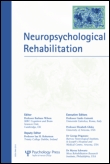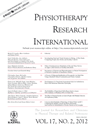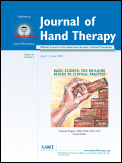
NEUROREHABILITATION
Scope & Guideline
Transforming therapy: where research meets real-world impact.
Introduction
Aims and Scopes
- Neurorehabilitation Techniques and Technologies:
The journal emphasizes research on various rehabilitation techniques, including robotic-assisted therapies, virtual reality, and non-invasive brain stimulation, aimed at improving motor function and cognitive abilities in patients. - Patient-Centered Approaches:
Research published often explores patient and caregiver perspectives, highlighting the importance of individualized care and the psychological aspects of rehabilitation. - Multidisciplinary Collaboration:
The journal promotes studies that involve interdisciplinary teams, integrating insights from neurology, psychology, physical therapy, and occupational therapy to enhance rehabilitation outcomes. - Outcome Measures and Assessment Tools:
There is a consistent focus on developing and validating tools for assessing rehabilitation outcomes, including functional independence, quality of life, and specific rehabilitation goals. - Innovative Rehabilitation Models:
The journal includes research on novel rehabilitation models, such as community-based programs and telehealth interventions, which aim to expand access to care and improve patient outcomes.
Trending and Emerging
- Robotic and Technological Interventions:
There is a significant increase in research on robotic-assisted rehabilitation and technology-driven interventions, such as exoskeletons and virtual reality, demonstrating their effectiveness in enhancing motor recovery. - Telehealth and Remote Rehabilitation:
The COVID-19 pandemic has accelerated interest in telehealth solutions, with a growing number of studies exploring their feasibility and effectiveness for delivering rehabilitation services remotely. - Holistic and Multimodal Approaches:
Emerging themes emphasize the importance of combining various therapeutic modalities, including physical therapy, cognitive training, and psychological support, to address the multifaceted needs of patients. - Focus on Quality of Life and Patient-Centric Outcomes:
Recent studies prioritize quality of life measures and patient-reported outcomes, reflecting a shift towards understanding the broader impacts of rehabilitation beyond just physical recovery. - Cognitive Rehabilitation and Neuroplasticity:
Research increasingly focuses on cognitive rehabilitation strategies and the underlying mechanisms of neuroplasticity, aiming to enhance cognitive recovery in patients with brain injuries or strokes.
Declining or Waning
- Traditional Pharmacological Interventions:
There has been a noticeable decrease in studies focusing solely on pharmacological treatments for neurological rehabilitation, as the field shifts towards more integrative approaches combining therapy and technology. - Generalized Neuropsychological Assessments:
While neuropsychological assessments remain important, there has been a decline in studies focused on broad, generalized assessment tools, with a greater emphasis now on specific, targeted assessments tailored to individual patient needs. - Single-Disciplinary Studies:
Research that focuses solely on a single discipline within neurorehabilitation is becoming less common. There is a trend towards interdisciplinary studies that combine multiple perspectives and methodologies.
Similar Journals

Journal of Neurorestoratology
Exploring the frontiers of neuro-restorative techniques.The Journal of Neurorestoratology, published by TSINGHUA UNIV PRESS, stands as a pivotal resource in the evolving fields of neuroscience and rehabilitation. With focus areas encompassing cognitive neuroscience and neurological disorders, this Open Access journal, launched in 2013, fosters unimpeded global access to cutting-edge research and breakthroughs in neuro-restorative techniques and therapies. Although it is relatively new, it has demonstrated its potential impact within the academic community, ranking in the 51st percentile for Medicine _ Rehabilitation and contributing novel insights in the realms of speech and hearing, neurology, and cognitive neuroscience. With its commitment to disseminating innovative findings and promoting interdisciplinary collaboration, the Journal of Neurorestoratology plays a crucial role in advancing our understanding and management of neuro-rehabilitation, making it a valuable platform for researchers, healthcare professionals, and students alike.

NEUROPSYCHOLOGICAL REHABILITATION
Transforming Neuropsychology: Insights for Better CareNEUROPSYCHOLOGICAL REHABILITATION is a prestigious peer-reviewed journal dedicated to the field of neuropsychology and rehabilitation. Published by Routledge Journals, Taylor & Francis Ltd, it stands at the forefront of research and development in applied psychology, arts and humanities, and rehabilitation, boasting an impressive impact factor and a distinguished ranking within various academic categories. With a strong commitment to advancing the science of rehabilitation and cognitive recovery, the journal aims to provide a platform for innovative research, systematic reviews, and clinical findings that inform best practices in the field. As it converges into its third decade of publication—from 1991 to 2024—NEUROPSYCHOLOGICAL REHABILITATION remains essential for researchers, clinicians, and students seeking cutting-edge insights and methodologies to enhance patient care and cognitive rehabilitation strategies.

NEUROREHABILITATION AND NEURAL REPAIR
Innovating Recovery: Bridging Neurology and Rehabilitation.NEUROREHABILITATION AND NEURAL REPAIR, published by SAGE Publications Inc, is a leading journal in the fields of neurology and rehabilitation, addressing critical issues in neurorehabilitation across a broad spectrum of neurological disorders. With an impressive impact factor and consistently ranked in the Q1 category in both Neurology and Rehabilitation, this journal is esteemed for its rigorous peer-reviewed research contributing to advancements in clinical practice and rehabilitation strategies. The journal boasts an HIndex that reflects its global influence and is highly regarded among professionals and researchers, ranking in the top tiers of Scopus metrics across various categories. Since its inception in 1987, NEUROREHABILITATION AND NEURAL REPAIR has fostered innovative research aimed at improving outcomes for patients with neurological impairments, making it a crucial resource for those engaged in clinical research and therapeutic interventions. Explore this prestigious journal to stay at the forefront of developments in neurorehabilitation, with access options available for diverse readerships.

Journal of Pediatric Rehabilitation Medicine
Empowering Children Through Innovative Rehabilitation ResearchJournal of Pediatric Rehabilitation Medicine is a leading academic platform published by IOS PRESS, dedicated to advancing knowledge in the fields of pediatrics, rehabilitation, and physical therapy. With an ISSN of 1874-5393 and an E-ISSN of 1875-8894, this journal has carved a niche within the biomedical community, focusing on therapeutic innovations and evidence-based practices in pediatric rehabilitation. Recognized for its scholarly contributions, it holds a prestigious Q3 ranking in Pediatrics and Q2 rankings in both Physical Therapy and Rehabilitation categories, indicating its impact and relevance in the respective fields. Operating out of the Netherlands, the journal provides a comprehensive open access model that ensures that research is easily accessible to professionals, students, and researchers alike. With converged years spanning from 2007 to 2024, the journal continues to be an essential resource for those dedicated to enhancing the quality of life for children with disabilities and rehabilitation needs, fostering collaboration between clinicians and researchers through high-quality research dissemination.

ACTA NEUROLOGICA BELGICA
Exploring the Depths of Neurological Research.ACTA NEUROLOGICA BELGICA is a leading academic journal published by Springer Heidelberg, dedicated to advancing the field of neurology and medicine. With an ISSN of 0300-9009 and E-ISSN 2240-2993, this journal has been a vital resource since its inception, contributing significantly to neurological research and clinical practice. It holds a respectable impact factor with categories spanning from Q2 in Medicine (miscellaneous) to Q3 in Neurology (clinical) as of 2023, indicating its prominence in the scientific community. The journal's extensive coverage since 1959 enhances its historical relevance, while its ongoing publication until 2024 ensures the latest developments are readily accessible. Researchers and practitioners can benefit from its rigorous peer-reviewed articles, which are crucial for staying current in this rapidly evolving discipline. As a scholarly platform, ACTA NEUROLOGICA BELGICA plays a pivotal role in disseminating knowledge and fostering innovation in neurology, making it a must-read for professionals, students, and anyone involved in the field.

Balneo and PRM Research Journal
Transforming clinical practice through open access research.Balneo and PRM Research Journal, an esteemed publication of the Romanian Association of Balneology, serves as a valuable forum for the dissemination of innovative research in the fields of physical therapy, sports therapy, rehabilitation, and the medical management of rheumatic conditions. With its commitment to Open Access principles since 2011, the journal ensures that groundbreaking findings are accessible to a global audience, promoting collaboration and advancing knowledge within the academic community. Despite its emerging status, as reflected in its Scopus rankings—with Physical Therapy, Sports Therapy and Rehabilitation ranked at the 25th percentile, and Rheumatology at the 21st percentile—the journal is positioned to make significant contributions to clinical practice and research. The journal is published in the heart of Romania, at Bucharest, and operates from 2021 to 2024, focusing on the intersection of balneotherapy and modern rehabilitation techniques. As a crucial resource for researchers, professionals, and students alike, Balneo and PRM Research Journal invites submissions that explore the latest advancements and clinical applications in these vital areas of health sciences.

Physiotherapy Research International
Advancing the Science of Rehabilitation.Physiotherapy Research International is a leading journal in the fields of Physical Therapy, Sports Therapy, and Rehabilitation, published by WILEY. With a commendable impact factor reflecting its significant contribution to the profession, this journal enjoys a competitive position, ranking in the 66th percentile and 84th out of 247 in its category according to Scopus. The journal encompasses a broad scope of research from 1996 to 2024, addressing critical advancements in physiotherapy and rehabilitation practices. Although it is not an Open Access journal, it provides valuable insights and research findings that foster knowledge and innovation among practitioners and researchers alike. As a Q2 category journal in its field for 2023, Physiotherapy Research International aims to facilitate the dissemination of high-quality research aimed at improving patient outcomes and guiding clinical practice. It serves as an essential resource for those committed to advancing the science and practice of physiotherapy.

Journal of Hand Therapy
Exploring the forefront of rehabilitation techniques.Welcome to the Journal of Hand Therapy, a premier publication dedicated to advancing the field of hand therapy through rigorous research and clinical insights. Published by Hanley & Belfus-Elsevier Inc, this esteemed journal, with ISSN 0894-1130 and E-ISSN 1545-004X, has been a cornerstone for professionals since its inception in 1987. With a commendable impact factor and categorized in the Q2 and Q1 quartiles for Physical Therapy, Sports Therapy, Rehabilitation, and Medicine, it ranks among the top journals in its fields, listed at #46/161 and #78/247 respectively in Scopus rankings. The journal aims to disseminate innovative research, evidence-based practices, and comprehensive reviews, addressing contemporary challenges in hand therapy, making it an essential resource for researchers, practitioners, and students alike. With a commitment to enhancing patient care, Journal of Hand Therapy is your gateway to the latest developments and trends in this critical area of rehabilitation.

Current Physical Medicine and Rehabilitation Reports
Empowering Professionals Through Cutting-Edge ResearchCurrent Physical Medicine and Rehabilitation Reports, published by SpringerNature, is an esteemed academic journal dedicated to advancing the fields of physical medicine and rehabilitation. With a focus on disseminating high-quality research and evidence-based practices, this journal covers a broad spectrum of topics including orthopedic medicine, sports therapy, and comprehensive rehabilitation strategies. While it currently holds a Q3 quartile ranking across several related categories, including medicine and rehabilitation, the journal aims to elevate its impact through open access to its content, fostering a global discussion amongst researchers, professionals, and students alike. Navigating the intersections of innovation and clinical application, Current Physical Medicine and Rehabilitation Reports serves as a vital resource for those seeking to enhance their understanding and practice in this dynamic field. With its evolving scope, the journal is committed to publishing studies and reviews that shape the future of rehabilitation and physical medicine practices.

Archives of Rehabilitation Research and Clinical Translation
Empowering Rehabilitation Through Open Access InsightsArchives of Rehabilitation Research and Clinical Translation, published by ELSEVIER, is a leading open access journal dedicated to advancing the field of rehabilitation research and clinical practice. Since its inception in 2019, the journal has made significant contributions to the understanding of rehabilitation methodologies and interventions, showcasing innovative research that bridges the gap between clinical practices and rehabilitation science. With an impressive impact factor and essential Scopus rankings—#56 in Rehabilitation Medicine and #94 in Physical Therapy—this journal is highly regarded in its fields and reaches a diverse international audience. The open access format promotes widespread dissemination of scholarly work, ensuring that vital research findings are accessible to all practitioners, researchers, and students worldwide. As a trusted platform for high-quality research, the journal encourages rigorous scientific exploration and fosters collaboration among professionals striving to improve the quality of rehabilitation services.